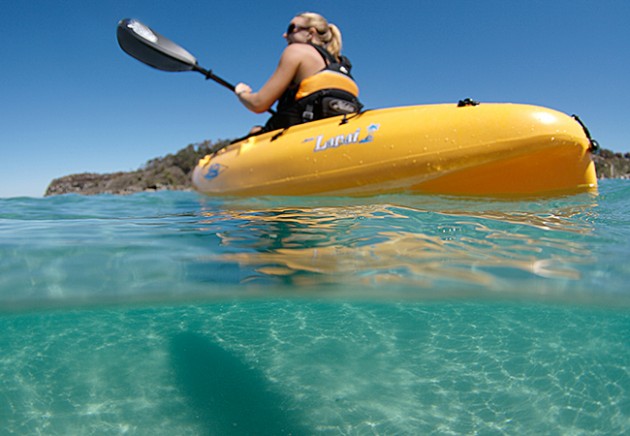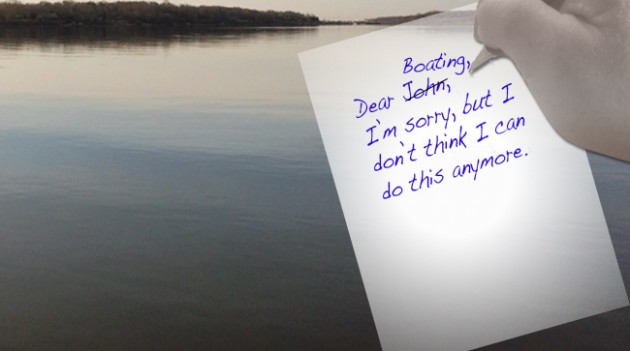Advertisement
Advertisement
Simple Boating: Which is More Fun, Kayak or SUP?
A typical boater tells the sport, “It’s over.” And the sport proposes a simple solution.
June 10, 2016
Dear Boating,
I’m sorry, but I don’t think I can do this anymore. Spending time with you is just way too complicated. Our time together has been wonderful, and you’ve made me a better person. But my friends say I will be happier if I let you go.
I hope that you can forgive me. I would still like to remain friends, if possible.
Sincerely,
Jane Doe
Dear Jane,
Please don’t leave me. It would break my heart. What can I do to convince you to stay?
With adoring love forever,
Boating
Jane’s reply: “Make it less complicated.”
Boating: I hear that a lot. But before you make such a life-altering decision, Jane, have you considered kayaks or stand up paddleboards? They are simple boating at its best, which is why they’ve become so popular recently. If you have time to listen, I can tell you more about each one.
Jane: Okay. But keep it simple.
Boating: Will do. Promise.
First of all, kayaks and stand up paddleboards (they’re also called SUPs) are human-powered. No engine, no sails. No fancy systems. That means a lot less time buying parts and fixing things. You can grab your boat in one hand and your paddle in the other and be on the water steering your craft in less than 5 minutes. Does that sound simple enough?
Jane: That sounds pretty cool, I must admit. But which one is better, kayaks or SUP?
Boating: Well, either one could be good for you. They’re pretty different. Here’s a little more information about each one so you can decide for yourself.

At 9 feet long, Hobie Cat's Lanai kayak provides simple boating for one person; it's easy to move around on and off the water. Photo courtesy Hobie Kayaks
Kayaks
Kayaks became a common sight along shorelines about twenty years ago, though they’ve been around as a niche boating market for much longer (and served as Eskimo fishing platforms centuries before they were paddled for pleasure). Rotomolded plastics and open deck designs have made kayaking a boating option for everyone—not just for those who have mastered the not-so-simple boating skill of rolling one back upright again. Fishermen have discovered them as a way to sneak up on their prey; adventurers set them up to tour long distance; and surfers have learned to catch waves sitting down. There are even models that carry sails.
For you, Jane, a kayak is a boat you can launch by yourself without much prep work, whenever the urge strikes for a harbor tour. You'll definitely be able to find an open-decked boat (also called a sit on top) that fits your body type. And tandems make it possible to take your dog, kid, or even a potential ex like me along for the ride, doubling the fun with only a minor increase in cost and logistics. You can buy a decent kayak for under $1000, and there’s actually a Walmart special for under $200.
Rotomolded models are very durable, so they can be left outside on a beach or boat deck without much long-term harm. Kayaks are also very stable underway, since your center of gravity is low. And you're already seated, so it's easy to relax and enjoy the passing scene.
I know you value your independence, so you should probably stick to the smaller models. That way you'll be able to load it on your car or move it to the beach by yourself.
Are you still with me?
Jane: Yup. Now I want to hear about SUPs. Why is it so popular, and how did it start?

Inflatable paddleboards allow you to store your boat in the trunk of a small car. Photo: PaulCroninStudios
Stand Up Paddleboards (SUP)
There's actually some respectable ancestry to this sport. Hawaiian surfers used paddles to improve their wave catching as early as the 1940s. And gondoliers have been standing to propel their passengers around the canals of Venice since the seventeenth century.
But flat water paddling for fun really took off in California about ten years ago, as something to do when the waves and the wind weren’t big enough for surfers and windsurfers. Next it spread across the country and around the world, faster than the latest juicy gossip about a celebrity breakup. According to the Outdoor Participation Report of 2013, stand up paddling had the highest number of new participants of any outdoor sport last year. And “more than half of stand up paddling participants tried the sport for the first time in 2012.”
Jane: But why did it get so popular so fast?
One reason is that pretty much anyone who can walk up a flight of stairs can master it on the first try. Grab a board, paddle, and lifejacket, strap on your board leash, step aboard, and you’re off on an adventure.
Jane: Standing up. Doesn't look very cozy.
No, not cozy, but versatile. Even in your living room, sitting down commits you to a certain location and position. On a SUP, your body translates a standing pose into more active interaction with your surroundings—and you can see farther ahead, giving you a little more time to react to whatever comes next. You may also be able to see down below the water’s surface, adding a third dimension to your on-the-water experience.
SUPs are also hard to capsize and easy to flip back upright again. And it’s easy to climb back onboard if you fall in the water, by accident or by design. That’s why they make such great swim and yoga platforms.
Jane: Sounds great. Any downsides?
Just a few: it will be harder to carry a passenger on a SUP than on a kayak, and there's no protection from the weather. It’s less a boat than a surfboard, though federal law does require a PFD and whistle when outside the surf zone.
Simple Boating: Making the Choice
So Jane, now that you know a bit more about the pros and cons of kayaks and SUPs, would you consider going forward with our relationship, as long as we can keep it simple?
Jane: This is a lot to absorb, and it's a really personal decision. But I do appreciate all the information. You're much more sensitive and less self-centered than I thought.
Boating: Thanks, I'm glad we've had this chat, and I hope you consider taking me back into your life. If you do, the best way to make this choice is to try a few of both kayaks and SUPs and see what better matches your style. Both are available to rent pretty much anywhere there’s water, so it’s easy to go for a quick spin and compare. Just make sure you are paired with a craft that matches your height and weight.
Jane: Thanks. I'll let you know what I decide. And I'm sorry I wrote you that awful form letter.
That's okay, I understand how frustrating it can be when spending time with me gets too complicated. I'm glad you let me explain that exploring a shoreline on a summer afternoon can be a simple pleasure: control of your own destiny, at only pennies per paddle.
And... I apologize if this seems sudden... but will you marry me?
Jane? Hello? Are you still there?
Read more:
- Hobie Mirage Pro Angler 12: Fish From a Kayak You Can Paddle or Pedal
- How To Choose the Right Stand Up Paddleboard
- Stand Up and Paddle: 10 Tips for Fun and Fitness
- Share the Water: Unspoken Rules of Sailors, Fishermen, Powerboaters, and Paddlers
- 7 Wacky Ways to Have Fun on a Boat (Don’t Tell Mom!)
Editor's Note: This story was originally published on boats.com in August 2014, then updated in June 2016 for National Fishing and Boating Week (NFBW).
Advertisement
Advertisement













